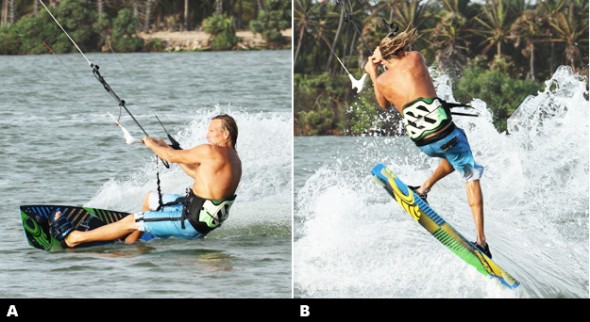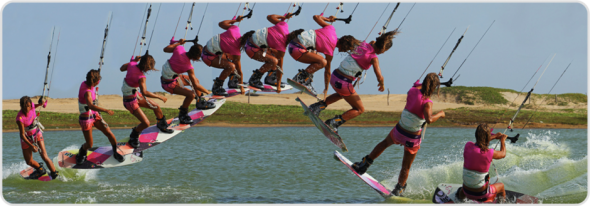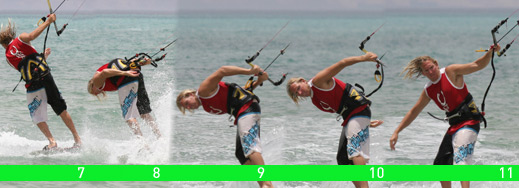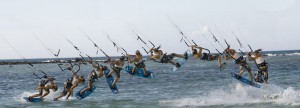KGB
The KGB is the next step on from a back to blind with an air pass. Much like the excitement of a Blind Judge 3, the add on is the final 180 of rotation so that you land heel side, therefore completing the move. It’ll have you laughing on the inside for weeks once you claim it, as that final float around to your heels is one mighty achievement. We will of course advise that you should already be stomping back to blind with air passes, as then it is more a matter of tweaking and polishing rather than learning something from scratch. If you did nail the Blind Judge Three it will help a lot, as you’ll already have built up some muscle memory to get the passing and kicking movement for the heel side landing.
- Approach and Carve Pic A.
In order to get the height, pop and slow enough rotation your entry into the KGB must be bang on. First off make sure you come in well off the wind, so bear away a lot before unhooking. Why? This will let you carve hard enough to get your rotation into the back loop without turning too far into wind, and therefore you’ll actually “do” more of the back loop in the air, and thus it will feel slower, giving you more chance to pass and turn. Secondly make sure you lean back towards the tail of the board as you bear away. You can see in the pit that the rider’s hips are leaning back over his back foot, and his shoulders are leaning back towards the tail of the board. This will help him invert, which in turn will make the pass both easier and closer so that he can pass later and therefore get all the way around to his heels. Finally don’t be afraid to have your kite a tad higher for learning this, as it’ll be more pleasant and confidence boosting knowing that there’s enough room to complete the manoeuvre.
- The Take Off Pic B.
Once you’ve got off the water with a right royal stamp against the back foot your aim is to get the board swinging up whilst you turn slowly through your rotation until you just about complete a back loop – but with the board up high and the bar in close. Here the rider has kept his hands in close to his waist from the off by locking his elbows in, and thus hopefully the bar will stay nice and close too and he won’t need superhuman strength to pass the bar. The rider’s head, although just about leading the rotation, is not looking over his front shoulder, but rather forward, perpendicular to his shoulders. This prevents him from spinning too quickly, thus helping him to turn the other way when needed and pass. Finally as his shoulders are still leaning back from the take off and his board rises the rider and brings his knees up and close, so that the board moves with him and doesn’t pull him down later in the move.
- The Inversion Pic C.
Getting the board up is what gives you time to pass the bar late and get your front foot through.
The timing and amount you turn can vary, but the more you complete the back rotation the better your KGB will look, much the same as a back to blind. The rider is coming around his back loop, not quite a full 360, but almost in relation to the angle he went off the wind to start, which gives him the most chance of landing comfortably downwind and not on an edge. Your aim is to get to this point with your board high and the bar still tucked in close to your hips. The further you come around the more your hips will come up towards the bar and save you having to pull your weight up to the bar, and this way you can rotate the opposite way for the pass without getting pulled backwards. Like many passes you will think you’ve left it too late, but this is your cue to go.
- Turn The Other Cheek Pk D.
Time to pull the trigger! Once you’ve completed the back loop you need to go for the pass before your board and legs drop and therefore pull you down and away from the bar. With two hands still holding the bar, The rider keeps his knees in and up whilst he turns his head to initiate the pass. The head should lead the entire move from here; if it does you can turn and claim the KGB. As you turn your head look up, not down at the water. The fact that the board and his feet have completed the back loop mean that the board is in front of him and therefore he won’t get pulled backwards away from the board but rather drop forwards towards it. This is not a bad time to give the kite a quick tweak down if you find that it keeps rising.
 However if you keep your elbows in your kite will naturally dip once you release your back hand, as all your weight will transfer to the front. The MAIN DIFFERENCE here to a back to blind with air pass, is that your focus is not on passing the bar but rather on spinning your head, body and board so that you can see where you’ll land. If you just concentrate on the pass you’ll drop down without turning the full 360 to heel side.
However if you keep your elbows in your kite will naturally dip once you release your back hand, as all your weight will transfer to the front. The MAIN DIFFERENCE here to a back to blind with air pass, is that your focus is not on passing the bar but rather on spinning your head, body and board so that you can see where you’ll land. If you just concentrate on the pass you’ll drop down without turning the full 360 to heel side.
- Forward Pass Pic E.
Looking forward to where you want to go will make you lead the rotation, so stretch your chin out in front of you and keep your eyes up. Normally you would turn your head down, and therefore pass but then drop down. In a KGB you must keep the head looking above the water, searching for where you’ll land. Here you can see the result – The rider is still turning as his head and body are leading the way. As the rider turns he rotates onto the bar and can therefore pass, but the priority is the rotation and therefore the pass from one hand to the other is late. Finally if you look at Christian’s front leg you can see that it is still bent. Keeping your landing foot close will guarantee that it comes with you and doesn’t get left behind. Once you get this far, prepare to scream and celebrate, as the KGB will be yours.
Top Tips
- The foundation for this move is a decent slow and inverted back loop, so repeat as many of these as you can, getting the board high and finishing your rotation at the apex.
- This will get you prepared and visually ready for the final 360. If your feet are dropping as you come around your back loop, you need more inversion, so more leaning back, more locked elbows and more knees up.
- We won’t be adding any common problems for this move, as it is a matter of concentrating on the relevant skills and putting them together – an inverted slow back loop, and a pass rotation lead by you head held high.
Keystones
- Massively off the wind
- Lean back towards the tail
- Hands in, knees up
- Full rotation to inverted position.
- Lead the pass with your head held high and front knee in.
Unhooked Front To Blind Ole
There are a few takes on the front to blind, powered, unhooked, hooked, sent kite, you name it and it’s probably likely. We’re adding the unhooked Ole to the list as it serves a couple of purposes. Firstly it does allow you to go for and learn the blind with a slightly higher kite. Secondly on a big lefty kite in light winds, you will often need to have the kite a bit higher and with the resultant upward pull on the bar “Oleing” out is a health conscious option – oh yes and it does have a different look and feel to a standard bar pass ending. Before you attempt this we’d suggest you can pop front roll, and preferably relay to blind, but if you’ve got the hooked version down then this is a mere step away. Following are a few points worth more than a moment’s consideration.
- Take off, pause and rotate Pic A.
As with all things unhooked and popped we’ll assume that you’ll have the bar trimmed correctly, hands centered and approach with good speed before bearing off with your weight back to unhook, dropping low and edging hard into your pop, stamping hard to get the height without a cheeky kite send. If you use your kite you’ll lose forward momentum and the landing will be difficult to pull off.
For extra lift when learning you can have your kite positioned higher, just above 11 or 1 o’clock – but don’t move it up. Here the rider has her kite parked at 11 o’clock and has just popped hard to get up off the water. What’s clear to see is that the rider has not yet started her front rotation; she is still looking forward to where she’s going. You too must separate the movement, even if only by a fraction of a second, but you need to pop before throwing your head and shoulders down and around. As a result you’ll get the height, if not you’ll be diving yourself down into the water and onto your back.
- Front Hand Pic B.
Whilst rotating around, especially if you have the kite high, it will be very tempting to lean on the back hand, and also very natural to have pulled on it whilst edging to pop. Therefore as you spin around it is very good form to keep applying a bit of pressure onto your front hand as this will both stop the kite from floating up above you, and it will keep the kite moving forwards, which will make the landing easier as you’ll have momentum. The rider is only just into her rotation but she is already “leaning” on her front hand. This means that when she finishes her rotation she’ll be able to pull herself towards the bar to throw the blind – if you end up hanging under the bar you can only spin to blind, which won’t offer you any consistency.
- Look Pic C.
We’ve said this before but whether it be a hooked front to blind or an S-bend pass the principal is always the same, another very brief pause between finishing your rotation and throwing the blind. This prevents you from over rotating and you have much more chance of keeping the kite in the air, rather than releasing one arm and starting the mother of all down loops.
Here the rider has rotated the full 360° and is focused again on where she’ll land. This momentarily slows her down, almost pauses the rotation, enabling her to set up for the blind. If not she would be spinning under her kite. From here she can now pull on the bar hard with both hands and throw the blind. With her head, hands and bar leading the rider can throw the blind and swing her legs through to turn far enough for the landing.
- Landing Pic D.
Landing blind for an Ole or pass needs to be flat on the board, downwind, not on an edge across the wind. This way you’ll be moving toward the kite and therefore there won’t be any tension on the lines.
Sc bearing away into the move is important, as this leads to a more downwind landing, and pulling hard before committing to the blind will also help. In the photo the rider’s board is off downwind so her momentum will keep her moving towards the kite. Now what differentiates an Ole from a surface pass here are the position of the rider’s body and her bar. The rider is standing upright over the board with her head high, not bent over double, and she is holding her bar high above her on an outstretched arm. This position is the perfect set up to an Ole.
- The Ole Pic E.
Firstly let’s remember what an Ole is. You will be moving the hand that is holding the bar, across, upwind of your head and shoulders to the other side of your body, from where you’ll be able to continue riding, but now toe side rather than blind.
That’s all it is, you’re not trying to turn the board or slide it around to bedside. It’s an upper body movement to get the bar across to the direction of travel and no pass is required. You can see in the photo that because she is travelling towards the kite the rider can push the bar upwind of her and then simply move her hand across in front of her face – now the bar is the same side of her body as the kite and the natural order of things are restored.
- The Finale Pic F.
You have a few options to finish things off, and regardless of what you do it’s a good idea to get both hands back on the bar so that you get control of the kite. Continuing on toe side shows good control, and will certainly confuse a few onlookers. That said if you land with a lot of power and speed the chances are that you will carve onto your heels, so keep going and ride out in the other direction. Here the rider has pushed the bar across, finished her Ole and is reaching for her bar. She has a lot of weight on her heels and as a result will steer her kite across the window once she has her back hand on the bar and follow it by continuing to carve on her heels.
Top Tips
- Apart from making sure that your popped front rolls are working off pat, the secret is to land blind and yes you’ve guessed it, pause foss split second before attempting the Ole.
- If you rush the Ole you’ll fall backwards or if you really rush the Ole you’ll start to rotate into it before you’ve even landed. So first land, balance and then push the bar.
Common Problems
- Assuming that you can get to blind the main issue will be falling backwards. This is normally a result of leaning back to push the bar across your face, rather than keeping your weight balanced and physically pushing the bar up wind and past.
- If you land on your toes across the wind the lines will tighten and you won’t be able to push the bar without it pushing you back, or you leaning back.
Keystones
- Pop then rotate
- Look and pause
- Pull with both hands then throw
- Land downwind and flat – pause
- Then push the bar upwind and across
NIS
It’s a game of grip, harder you grip smarter you perform. We really appreciate your love and affection for this sport, which indeed is a plus point for health and working environment. Benefits are many and space is short to write, just wanted to summarize all the thoughts in one line “keep yourself moving until and unless something strange won’t pack you in a BOX.
Let’s talk about today’s trick from very beginning. Even if you already have an inverted Slim Chance in the bag, adding the non-inverted variant to your repertoire will be both satisfying and worthwhile. It’s likely that many of you and in particular some of the “old timers”, went on to master the Slim as the next step after the long forgotten dangle pass. With the result you may have a habit of sending the kite a bit and having a somewhat dangly finish to what started as a powered pass.
Getting your teeth into the NIS is a great cure for this. If you don’t suffer this problem, well it’s still another trick to claim and if you’ve never tried any sort of Slim Chance, now is the time. What should you already be confident with to try this? The base for this is a powered unhooked popped front roll, preferably to toe side, as that’s the way you’ll be passing. If you can already Shifty to wrapped, or even better Shifty 3 then you’re almost there, and if you can Front to wrapped then you’re knocking on the door That said your front rotation may not need to be inverted, but you do need to get the knees and board high, so the more aggressively you can pop, the easier this will be.
The Important Bits
- Approach and Edge
Pic A
Your first pass would be easier if you get good pop on your take off, it will be more to do with timing than brute force. And to get good pop your approach and subsequent carve onto your edge needs to be dialed in. It’s really important to get speed in starting, if you’ve got enough power great, if not work that kite to get some pull and speed. Secondly park the kite where you want it to be, let’s take it around 11 or 1 o’clock, so that you know it won’t drive you down and therefore give you the confidence to pop hard and not lift the kite as you edge. Finally get your body back over the tail of the board as you bear away, so that once you unhook not only will the kite be in the correct place, but also you can turn back onto a solid edge with your weight low very quickly, which is the crux of good pop. You can see in the Pic A that as the rider carves onto his edge and away from the kite his front leg is extended, his back leg bent but locked and his bum is low – a result of the correct entry position. From this point he is ready to pop hard.
- The Take Off
Pic B
If you’ve got the approach right you’ll have so much edge and bite as you turn the board upwind, that as long as you commit you’ll get plenty enough pop to complete the move without lifting the kite. Your board, knees and hips will be thrown up high enough to make the pass. Even though you’re throwing a front roll, you need to be as low as for as for a raley, uber edge your aim is to get yourself as much height as you can, which will give you time, so as you stamp hard against the back of the board, explosively extending your back leg, concentrate on extending from your back leg all the way up into your back shoulder. This way even as your head goes down and around and your front knee lifts to initiate the rotation, you’re still on the way up. In Pic B you can see the spray that the rider has following him, a definite rooster tail. As he goes down into the front roll he’s still rising. Just as importantly by popping hard Christian is able to bend his arms and pull his hands towards him, keeping the bar in close. If you don’t get the bar in now, you’ll have an almighty task ahead of you. Finally with the bar in close it is more achievable to keep the kite parked with the bar angled forward – if the arms extend you’re likely to pull on the back hand.
Pic C
It should be looking like at the 180° mark if all is going well this is what. Please watch carefully, the board and knees high, swinging around with your shoulders, not dropping and pulling you down. You need to be leading with your head, even though you’ll be throwing the pass against the rotation, as you need to see where you’re going so that you can time the movement. The rider is coming around and he still has his hands in close, if he were to rotate another 90° he would find his front hip nearing the bar. You don’t want this, so once you can spot your landing you have two jobs. Pull the bar in towards your hips, and pull your old back knee, in this case the rider’s right, towards the bar. They don’t actually have to get very close but this will slow your rotation and lift that end of the board, giving you more chance to make the pass.
- Do It
Pic D
This is the make or break moment requiring full commitment and energy. Timing wise you should be just about to drop, that lovely floaty nanosecond before free fall. Most likely it will feel too late, and if it does that’s perfect! In short you pass as you drop out of your rotation. Whilst your knee and bar move towards each other you have to turn your back on proceedings. Give one last tug on the bar with both hands, a bit front hand heavy to stop the kite flying up when you release it and then throw you head and shoulders back around, down and away from where you’ve been looking. Assuming you’ve already been wrapped or passing the drill is the same, fast and deliberate, twisting the bar as you release your front hand to allow your shoulders to turn further. In the picture the tail of the rider board is high, his knee and hip are close to the bar and he’s leading his pass with his head. He also has his complete kite face on, as this is 100%. With the board high and his knees bent the board won’t drop and pull his away from the bar as he turns.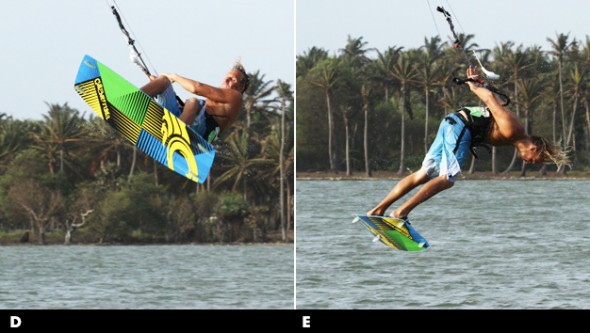
- The Pass [Pic E]
Now it’s hand to hand, which sounds obvious, however if you twist the bar fully and hold on tight your body will wrap around your arm, follow your head and the bar will present itself to your waiting hand. As long as it’s looking for the other hand and not scratching around in the small of your back. Here in this image the rider free hand finds the other one and grabs the bar. Now it’s just a matter of landing it, claiming it and riding away without looking too surprised.
- The Landing [Pic F]
This is a normal tendency that we don’t always think about the landings too much, but this one does require some anticipation, or else you’ll be passing, getting excited and then diving in. You need to be ready to ride as you land, hopefully downwind and maybe even further around. There are two things that really help. Firstly keep your head turning. It’s common to freeze the head whilst changing hands, and this often leads to a fall, so as you change hands keep turning the head to look towards where you’re going. Secondly untwist the hand, that is to say allow your wrist to turn palm down so that the bar is once again as it should be and the status quo is restored. By doing this your shoulder can turn up and forward and you’ll be better balanced to follow the kite. In the picture the rider’s hand is the right way up and his head is trying to look around, following his eyes.
Top Tips
- Your first key of success is “Preparation”, hence make sure you’re in a dynamic stood, as you’ll need to rotate quickly for the pass, and bang out a few popped front rolls
- Be focused on bringing the knees and hands closer as you’re coming around. Beware though, as this will kill your front roll rotation so be ready to land toe side and off balance
- At time you have done enough fronts that time is slowing down, you’ll get an idea of when you can pass. If you are able to bang out a few Shifty to Wrapped,or Shifty 3s, even better. It’ll get your pass rotation well and truly warmed up.
Common Problems
- Pop issues are common with front rolls as by the very nature of the rotation it’s very tempting to throw yourself down before you’ve gone up.
- Also there is a tendency to stand more upright whilst edging to pre-empt the take off, but you must edge low and hard, then stretch up to get the necessary height
- The problem with all passes this way is that the kite loves to rise, either as you pull or once you release. The beauty in the NIS is that as you’re waiting for the moment to pass, you have time to sneakily steer the kite down before or whilst pulling. Do this and the pass will be noticeably easier as you’ll practically manufacture slack
- Getting the knees and board up can be a problem. For the inverted Slim you can throw your shoulder down and head back to get the legs up. Whereas here it’s all about pop. However keeping your hands in close with bent arms will mean that your balance point will be more around your waist and therefore you’re more likely to rotate around this axis
- If your arms are stretched out it’ll be much harder. Finally the landing. Passing like this does encourage you to look down at the water as you throw your head, which works wonders for the pass but doesn’t do jack for the landing. So make sure you try and move your head after passing and untwist your hand.
Keystones
- Good approach and solid pop
- Hands in close
- Bring hands and knees together
- Pass late, as you drop
- Keep looking
Toe side front Roll To blind with Ole
We hope you are grooming well with the aid of our articles and learning every trick carefully. With ever learning day, you are going to be perfectionist in this sport. We always emphasize on doing every trick with right way and right balance, so that your every step of learning should be placed on right path. The trick which we are going to learn today has a better name, but for the moment we’ll stick to the descriptive version. Fundamentally this is a pop trick, but a subtle drifting up of the kite is more than tolerable to get you easiness to learn this trick. For those of you confident with your toe side edge this is a great trick and an inspiring step on from the toe side pop to blind which is a good prerequisite as you need both a decent pop from your toes and the blind that very same side. If this will be doing it first time, let us advise again that it will be easier to pop from your strong toe side to a new and unvisited blind rather than try and pop from your weaker toe side. Popping well from your pinkies is the key here.
The Approach
We need two things in order to pop from your toes, first speed and then a good solid edge. With the board fizzing over the water it’ll be a doddle to get it up and you’ll have momentum when you get it around. Looking at Pic A. you can see that the rider pre pop. First off the rider has his bar trimmed in close so that he can get an aggressive edge and hold the power with two hands without being pulled up onto the board. This way he can turn his head and shoulders away from the kite and stand up onto his toes, hips forward, driving the board between him and the kite. The rider has shifted his weight back on the board ready to pop, as this will help him add tension to the lines by edging harder. However if you need more speed you must keep the front knee bent and the board trimmed flat before shifting your weight back.
The assumption behind popping is much the same as from heel side – once you have enough speed, carve  up hard and stamp off the back foot. Though bearing away and then carving up from toe side is no simple task, so for the same sort of effect shifting your weight back will dig the tail in and turn the board upwind on its rocker. The trick is to be quick, shift your weight back and stamp – wait and you’ll lose your speed and nothing will happen. In Pic B. the rider has leant his weight back and simultaneously drifts the kite up slightly from 11 o’clock to give him a bit more lift whilst stamping down hard by explosively straightening his back leg. As he pops up he turns his head and shoulders down and around, initiating the front roll.
up hard and stamp off the back foot. Though bearing away and then carving up from toe side is no simple task, so for the same sort of effect shifting your weight back will dig the tail in and turn the board upwind on its rocker. The trick is to be quick, shift your weight back and stamp – wait and you’ll lose your speed and nothing will happen. In Pic B. the rider has leant his weight back and simultaneously drifts the kite up slightly from 11 o’clock to give him a bit more lift whilst stamping down hard by explosively straightening his back leg. As he pops up he turns his head and shoulders down and around, initiating the front roll.
The Rotation
The rotation will be very quick as with every front roll from toe side. This is handy, as you’ll need to spin quickly to allow for the extra twist to blind. Aim to keep two hands on the bar until you are coming around the first 360°, as this will keep you more upright and lead to a smoother landing. Looking at Pic C. as Christian reaches this point you can see that he is leading with the head. This is important; as he will know when to initiate the blind once he spots his landing. The rider here also has his knees bent and board up to help encourage a quick rotation and he keeps the bar in for that little bit of extra float. As he focuses on where he’ll land he releases his back hand, turning his head and shoulders down and around under the bar so that he can get his body around to blind whilst the board is leading. This way the board will be beneath him and ready for touchdown.
Throwing Blind
We can see in Pic D. that the rider has “thrown” the blind with the result of turning his head and shoulders down. As he drops his feet and board are leading the way. Whilst turning, he tweaks the kite down by pulling gently on his front hand. This will guarantee a bit more speed and forward momentum for the Ole, and is necessary if you sneak the kite up for takeoff.
As with all things Ole or pass you’ll need to land blind on a flat board heading at least a tiny bit downwind towards the kite. This way you’ll have no tension on the lines and so the Ole should be a walk in the park. Pic E. the rider lands upright over his flat board, having thrown the blind enough to land slightly off the wind. Try to keep your head up, as this will prevent you from breaking too much at the waist, which can in turn force weight onto your toes and put tension on the lines! If anything you want to be leaning on your heels. Landing this way the lines will be slack and therefore the bar will be close to you, not twisted around leading the way and pulling you over.
Landing upright on a flat board heading towards your kite sets you up perfectly for the grand finale, the Ole. Pic F. Standing over his board the rider can now push the bar upwind and around in front of him, so that the blind miraculously transforms back into toe side. Once the bar is across get both hands back on it, sheet in and ride off with a hefty grin on your face.
Common Problems
- If you’re not getting enough pop from toe side try sailing more across the wind before dropping your weight back and popping.
- If the kite is falling out of the sky as you land make sure that you are both popping hard into the front roll and that you give the bar a tweak forward to keep the kite from drifting too far up.
- If you slide under the kite on landing try throwing your blind more aggressively by turning your head and throwing your free hand around.
- If you’re getting pulled over & catching your heel side edge, you’re not landing enough downwind.
- If you can’t Ole and the kite pulls you over you’re edging on your toes whilst blind, so make sure your weight is on both your feet, biased towards your heels.
Keystones
Indy Pop to Blind
Before trying Indy pop to blind trick you must be reading well below instructions and practice it with right way. You can have every possible trill which is there in kite surfing. By understanding what to do and how to do can make all the difference.
And as we have often said it’s a great way to freshen up and reignite your passion fats move that you already have in the bag – so it’ll not only look the puppy’s but also feel do booth! Here we have a hooked in pop to blind with a back hand grab on the toe side rail in between your feet. You should already have the ability to pop around to blind and ride and if you don’t then hopefully this will be the incentive you need to learn.
The Set Up- Pic A
When you search for your pop you will require two things, the obvious one being speed with a dose of power and the less obvious one is a good body position, which is always much required. Whilst learning you can afford yourself the luxury of a third one, which is lift from the kite. No need to have it down at 45° when a forgiving 1 or 11 o’clock will help you on your way. Here we can see in the image that the body position as the rider carves back up into her pop. Her front leg is extended, meaning that her hips, and weight are pushed back towards the tail of the board and her shoulders are also leaning back. Surfer adopted this position before she turned off the wind and has held it throughout her carves. This very sturdy position enables her to pop explosively off her back leg. Before we continue take note that your hands should be centered on the bar and your kite parked still.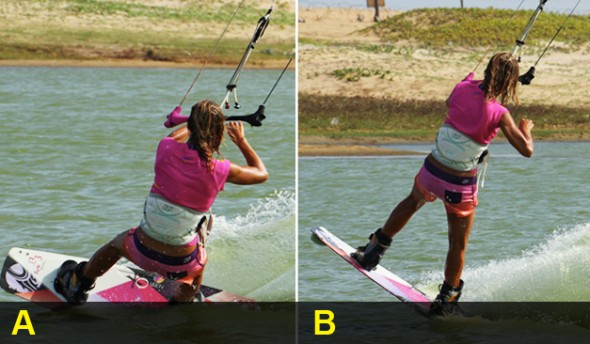
The Explosion Pic B
From such a solid set up the pop should be easy and simple. As long as you turned off the wind before carving up both the kite and the board will behave, that is to say the kite will give you something to pop against and your board won’t slow down too much as you carve. To get maximum pop you must keep your shoulders back and upwind of the board, your bum low and close to the water and you must not soften your back knee as you carve up. The rider has stamped down hard against the board with her back foot, explosively kicking herself away from her edge, and with her weight back and she takes off nose first. In anticipation of not having much time to grab she is already releasing her back hand from the bar as she stamps.
Board Up Pic C
As with any pop you need to wait until you’ve extended your body to get full elevation up, but as soon as you have it’s chop-chop to get the grab in. In picture, having already released hand, her next job is to bring her knees up towards her so that the board is within grabbing distance. The rider looks down towards where she’ll grab as she lifts the board and keeps her knees apart so that there is room for her arm to reach down towards the edge of the board. Also as a result of popping hard the back of her board kicks around and out slightly which has the effect of turning the rider back and away from the kite. This is good as it pushes which in turn gives her more room to reach down with her back hand.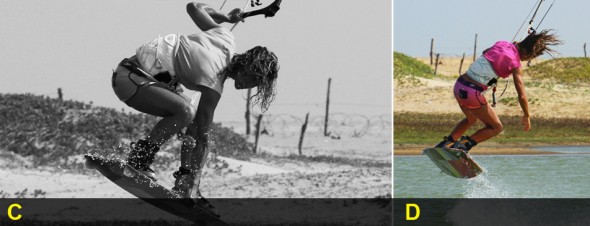
The Grab Pic D
With the board flicking around, roots for the back hand to reach down and the knees pulling everything up she can happily grab the board for a solid Indy. In this picture you can see the result of all that has gone before – the bar is in front of her and she has plenty of roots to reach and hold the grab without the need to be a contortionist. Whilst you have the grab sirs to keep the bar in on the sweet spot so that you’ll have a modicum of support from the kite, you’ll keep your forward momentum for the landing, and you’ll be able to dump the pull when you need to turn to blind.
Throw the Blind Pic E
A very good thing about the grab is that it naturally makes you stall your turn or throw to blind. Blind is always a last second movement, hence why we can do a by pop to blind. The higher you go, the longer you have to wait in order to keep your balance and control the landing. Once you feel that you’ve got the grab and you know that you’re coming data it’s time to turn. The action will come from your hips and your back leg whilst your free arm will balance you. The rider has released her grab and now commits to blind. To turn the board she twists her hips and pulls her back leg up towards her bottom and around towards the water. The board will naturally want to fall tail first so she focuses on pulling her back leg up. By doing this she will rotate around her harness hook and should make it all the way.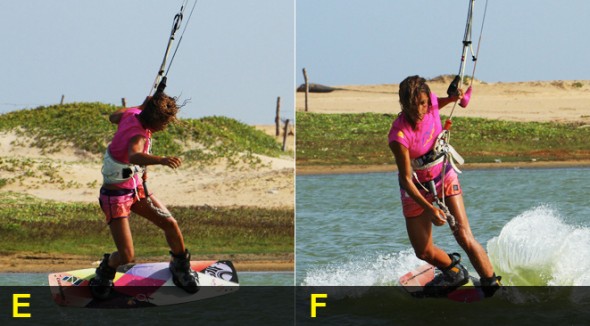
Landing Pic F
Landing this should be as per your pop to blind, though chances are as you’ve had more height you will have less momentum to keep you going once you plant the board. Make an effort to keep your back foot up so that you can plant the front of the board into the water for landing. This way as the nose catches the board will pivot off the wind more and you’re more likely to keep moving. If you land flat on your edge you’ll just stop. You can see that the rider has landed nose first with her front leg fairly straight, whilst her back leg is bent so that the board will turn further away from the wind on landing
She is already in her default blind position so that she will keep moving. If you have slowed too much pull the bar in to get some oomph from your kite.
Top Tips
- First of all you should practice the Indy if you never tried it before.
- Getting the board flicking you slightly around on take-off does make the movement of turning to blind in the air much easier as you have less far to turn and thus your body is in a better position.
- Try looking back at where you came from as you grab, this will help you turn during your Indy.
- Although we’ve said you don’t want your kite too low, don’t have it any higher than 11 or 1 o’clock. It still needs to be pulling forward to allow for some flick, an easy grab, and momentum on landing.
Common Problems
- If you can’t reach to the grab then ensure you’re popping hard enough. The pop will help you lift the board as the water will cork the board back up at you.
- Also make sure you turn to face slightly back to get the bar and your harness out of the way.
- If you’re falling backwards as you land. If your body is further downwind than the board when you land you need to sheet the bar out as you throw the blind.
- If you’re landing and then falling chances are that you’re landing flat or tail first, so concentrate on keeping that back foot up and close to your bottom so that the board can pivot.
Keystones
- Turn up and pop hard
- Release back hand and look for grab
- Lift board and look back
- Throw to blind using hips and back leg
- Keep back leg up to land nose first
Back Loop to Blind
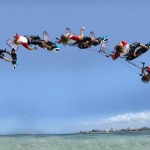
This moves shows an absolute control and beautiful trick in its own right, it is also the final building block to a couple of world class air pass moves. Once nailed you will be the envy of many at your local point, and it will spur you on with a new found confidence to try more technical tricks that not so long ago seemed impossible to reach.
THE BACK LOOP
First, your unhooked popped back loops need to be 100% accurate and controlled. By this we mean that you need to be executing a popped rotation at a slow pace. This will result in your land facing downwind. Such a back loop will also result with your landing with slack lines with no pull from the kite and a feeling that you’re actually dropping down. To achieve this, the three things to remember are the head position, kite and the point of sail. Try not to use your head for rotation, just look forward where you are going to take-off and leave your head square with your shoulders.
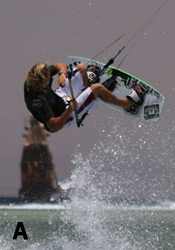 In picture A, the surfer is coming around his rotation but isn’t
In picture A, the surfer is coming around his rotation but isn’t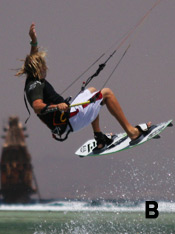 looking over his shoulder. This way you’ll not suddenly be round and landed, but will have that split second to think about throwing it to blind. You need to have the kite a tad lower than your usual measure. If it is 11 or 1, you will be less likely to spin under the kite and there will be something to pull against to get your knees up and the rotation to blind starts as in picture B. You can see the surfer is really pulling his knees in before throwing to blind.
looking over his shoulder. This way you’ll not suddenly be round and landed, but will have that split second to think about throwing it to blind. You need to have the kite a tad lower than your usual measure. If it is 11 or 1, you will be less likely to spin under the kite and there will be something to pull against to get your knees up and the rotation to blind starts as in picture B. You can see the surfer is really pulling his knees in before throwing to blind.
Where you take-off is where you land. So if you want to land more downwind, you need to take-off more downwind. The real advantage of this is that if you start your back rotation in the air, sometime before the board passes through the wind; your brain has time to react and ponder the blind a bit. If you take-off into the wind, you will be able turn around before you have time to pull.
So once again before attempting a back to blind, hammer out back loops to get the first part automatic!
THE BLIND
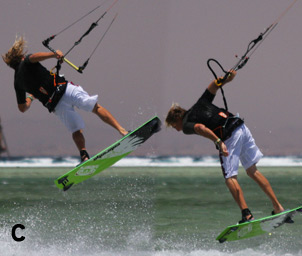 The blind in the Back loop to blind is made more difficult than a front to blind because it is by the fact that not only you are throwing to blind, but you actually have to break your rotation and turn the other way. In the raley, your body is trying to twist the wrong way so it should have trained you in a certain level.
The blind in the Back loop to blind is made more difficult than a front to blind because it is by the fact that not only you are throwing to blind, but you actually have to break your rotation and turn the other way. In the raley, your body is trying to twist the wrong way so it should have trained you in a certain level.
As mentioned already, your head, kite and point of sail will be crucial here. By not looking for your landing over your shoulder, you’ll find it easier to change the direction that your body is travelling in. With the kite lower, your feet will be higher and your body will be in a horizontal position sp you can pull against the bar to stop the initial back rotation and go the other way around. And having taken off earlier, you can rotate more slowly which in turn means that there will be less momentum to fight against.
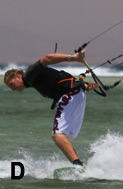 Do not forget to turn your head and twist your wrist, pointing your thumb at where you are going as in picture C. This will help your shoulders turn further, enabling you to turn the board further and stick a more downwind landing with the bar in the right place (picture D) to grab when you go for the surface pass.
Do not forget to turn your head and twist your wrist, pointing your thumb at where you are going as in picture C. This will help your shoulders turn further, enabling you to turn the board further and stick a more downwind landing with the bar in the right place (picture D) to grab when you go for the surface pass.
Once you have mastered a load of back loops, do the same with several raleys to blind and then you will be ready!
SHOWTIME SEQUENCE
Following the sequence which is relatively low and in very light wind will give a good way of confidence. Do not forget to make sure your leash is on the correct side.
pic 1 – The surfer come up over the board flat off and unhooked knowing that the coast is clear. His kite is around 1 o’clock and his hands are together in the middle of the bar.
pic 2 – From a broad reach the surfer carves hard against the power in the kite, front leg extended and back leg flexed and ready.
pic 3-4 – As the board turns upwind, the surfer extend his back leg and pops up. The surfer also keeps his arms bent as this will make the pull in for the twist to blind much easier.
pic 5 – Due to the pop and the kite position, the surfer is pulled into a more horizontal back loop.
pic 6 – As the surfer comes around the back loop, the board is behind and up in the air, almost where it would be during a raley. This is the moment to throw the blind and later on you will miss the chance as the board will start to drop.
pic 7 – The surfer pulls the bar hard towards his front hip to initiate the twist to blind. If the kite were much higher, this would be harder as it would not turn. At the same time the surfer turns his head in the opposite direction and keeps his knees up.
pic 8 – To make sure, the surfer turns far enough and looks around towards the direction of travel.
pic 9 – The surfer will then be able to turn his thumb down and forwards, twisting the bar which moves the shoulders further around, therefore allowing the surfer to get his upper body low.
pic 10 – So now an arc has been created, the surfer can easily pass the bar behind the small arc of his back.
pic 11 – And finally, the surfer turns to face the new direction of travel and sort it out.
Here´s what it will look like when you master this trick:
Unhooked, Front Roll To Blind
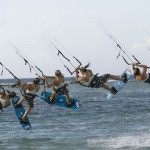
Unhooking and adding a revert to blind can spice up any trick and make you look like you have more game, even a simple front roll becomes something special once you spice it up.
Riding left to right, front foot forward with the kite above 45 degrees, trim the strap to unhook the bar, unhook and ride a short distance to check you have trim spot on.
To make lide easier and to gain an extra rotation time for the landing to blind, send the kite up a little as you pop from the water. Tuck your chin to your right shoulder and look behind you over your right shoulder as you pop to start the rotation.
Half way through the rotation, you should start to spot the landing by looking over your left shoulder. As you come in to land instead of letting the board follow your body round, take your right hand off the bar and swing your arm down towards the water, this will give you enough counter swing to stop your body rotation and land blind.
As you land, bend your knees to take the landing, keep your weight firmly centered over your feet. If you feeling up tp it you can ride out the trick with surfaced handlepass.
Good luck with this cool trick!
Tips! Make sure that you trim correctly to unhook before trying the trick. when landing blind lean forwards and towards your back foot, to help keep the edge.




